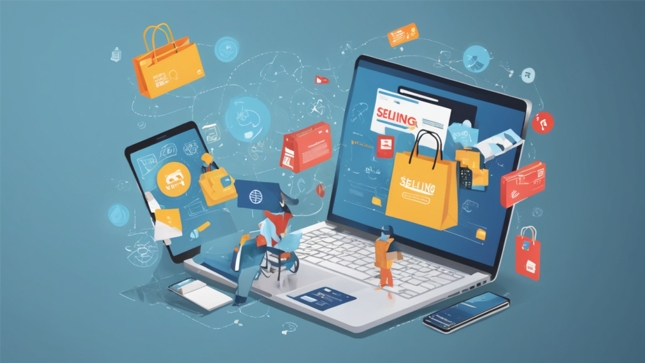Define Your Unique Selling Proposition (USP) + 5 examples

What Is A Unique Selling Proposition and Why is it Important?
A Unique Selling Proposition (USP) (also known as a Unique Selling Point or Unique Value Proposition) is a distinctive factor or characteristic that sets a brand, product, or service apart from its competitors in the eyes of the target audience.
Your USP is the backbone of your brand identity as it helps a business effectively differentiate itself and communicate its value proposition (VP) to potential customers. It directly impacts the first impression customers have with your business, making it a crucial element of any marketing strategy.
Essentially, a well-defined USP communicates to the market that you are something unique. It stabilises your brand identity, breathing life into your marketing and conversion efforts.
How A USP Works
A strong unique selling proposition is usually just a short sentence or two that sets your brand apart. When used on a landing page, it is often phrased as a slogan. Your USP gets your potential buyer’s attention by pulling at their heartstrings as a result of addressing something very important to them. (A business owner (or the founder of the business) will usually decide on the USP when first creating their business, or when the brand goes under a massive restructuring in it’s identity.)
A business’s USP acts a differentiator to:
- attract target customers
- retain them by going beyond addressing the basic customer needs
- clearly communicate that what you’re selling is more than just an easy fix to the problem your customer is facing
Overall, it makes your business significantly more attractive to the customer, and often leads to loyalty through shared values as a result of the company’s unique position built from their USP.
Strong Unique Selling Proposition Examples
Below are examples of how a successful business creates an effective USP – one that resonates with their customers.
Stripe
“Financial infrastructure for the internet.”
Stripe targets developers by offering full control over online payment processes, distinguishing itself from competitors like PayPal.
Bee’s Wrap
“That’s a wrap on single-use plastic.”
Bee’s Wrap promotes sustainability by providing an eco-friendly alternative to plastic wrap, aligning with the global concern for reducing plastic waste.
Fabletics
“We can’t fix your lives but we can fix your activewear.”
Fabletics focuses on personalized activewear through an online quiz and VIP membership program, catering to customers tired of traditional brands.
Nike
“Just Do It”
Encapsulates Nike’s commitment to inspiring individuals to pursue their goals and aspirations, regardless of obstacles they may face. By using this USP, Nike motivates people to push their limits and strive for success.
ASKET
“The world doesn’t need another fashion brand.”
ASKET’s USP takes note of changing consumer behaviour in fashion. It then leverages this trend and phenomena to promote conscious consumption by offering high-quality essentials and transparency in production, appealing to consumers seeking sustainable fashion choices.
Apple
“Innovation and User Experience.”
Apple’s USP revolves around delivering cutting-edge technology in a user-friendly package, prioritizing innovation and user-centric design. This focus differentiates it in the tech industry, creating a sense of aspiration and exclusivity among consumers.

Define Your Unique Selling Point
Defining a USP requires identifying what makes your brand unique and understanding how it adds value to your customers. This could be based on the quality of your product or service, exceptional customer service, innovative solutions, or any other factor that differentiates you from the competition.
Steps to Developing a Unique Selling Proposition for Your Brand
Determining your unique selling proposition can be a fun and insightful activity for your business. It’s often best to get this done when starting your company, and to revisit it when major changes occur to your business (if at all), like positioning, service offerings, etc.
Take the following steps to create your own USP in a structured and informed way:
- Market Research
- Conduct thorough market research to understand your competitors, industry trends, and gaps in the market that your business can fill
- Identify Your Target Audience
- Find the market segment in which your business has a great product-market fit so that your marketing efforts convert well
- Create the relevant customer persona(s) based on this target market, including their pain points, buying behaviours, values and preferences.
- Define Your Competitive Advantage
- Identify what sets you apart from competitors in the products or services you offer (this could be related to product quality, pricing, customer service, or innovation)
- Determine how well you meet the needs of your target audience
- Craft Your USP
- Develop a strong statement that conveys your USP clearly and succinctly. Focus on one specific aspect that sets you apart from competitors and resonates with your target audience
- Ensure that your USP addresses why customers should choose your business over others
- Tailor Your Messaging
- Make informed branding and marketing decisions bycustomize your USP message in line with the customer persona identified earlier
- This ensures you can communicate your unique selling point in the most effective way by aligning their values with your offering
- This way, you effectively meet the specific needs and desires of different customer segments within your target audience
Communicating Your USP in Marketing Messages
A company’s USP isn’t made effective in one step. In fact, a successful USP goes beyond sitting idly in your business plan. Great unique selling points have two key aspects to making them successful:
- It is created with a customer-centric focus to be truly unique for the target audience,
- It is effectively communicated in the brand identity and marketing messaging.
Since your USP can be communicated in many ways, finding a good copywriter will help make the process a lot smoother, leaving you with an effective, conversion-driven message.
Successfully communicating your USP across your channels is essential to:
- Attract prospective customers
- Retain customers and create loyalty
- Set yourself apart from the competition
No matter your mode of digital marketing (emails, social media, website) or offline marketing (posters, direct mail, billboards), your USP should be prominently featured in every key touchpoint of the customer journey to create a lasting impression on your target audience.
Tips To Creating A Successful USP
Remember that your USP promises a set of values to your customers. So, here’s how to make it entirely unique; differentiate your brand from the competition; and truly resonate with your audience.
- Keep it concise and clear
- Focus on what makes you unique and differentiate from competitors
- Make it customer-centric by emphasizing the benefits and/or values of your brand and engaging with you
- Be clear and confident in communicating it
- Tailor it to your market’s values to connect with the audience
- Use active voice and power words for greater impact
- Test & refine different ways of communicating it with text and visuals across different channels

How to Identify Your Unique Selling Point
A USP can be applied to both a brand or product
For example, your brand can have an overarching value proposition which serves as an umbrella under which all your products have their own unique selling propositions.
Fabletics, for example, is an athletic wear company focused on good quality, affordable design and comfortable clothing. They may have the following USPs for different product lines:
| Athletic Wear (primary line) | The main USP could be the combination of high-quality materials, trendy designs, and affordability, catering to fitness enthusiasts looking for stylish yet functional workout gear |
| Athleisure Wear (sub line) | May have a different USP focusing on versatility. While the main brand’s USP of comfort and fashion-forward clothing is still retained, this product line focuses on designs suitable for both workouts and casual wear |
| Accessories Line (sub line) | This USP could be centered around complementing their activewear with high-quality accessories like bags, hats, or shoes that enhance the overall fitness experience for customers |
By tailoring specific USPs to each product line, brands like Fabletics can effectively target different customer segments and meet diverse needs within their product range. This approach allows the brand to highlight the unique benefits of each product category and appeal to a broader audience while maintaining a cohesive brand identity. It gives your more juice for content marketing
Identifying your unique selling point requires a deep understanding of your ideal customer and target audience. By knowing their needs, preferences, and pain points, you can tailor your USP to resonate with them effectively.
Differentiating Your Brand from Competitors
To differentiate your brand from competitors, focus on what makes your product or service stand out. Highlight the unique benefits and features that set you apart and address the specific needs of your target market.
Understanding Customer Pain Points
Understanding customer pain points is key to developing a compelling USP. By addressing the challenges or problems that your customers face, you can position your brand as a solution provider, making your USP more appealing and relevant.

Strong USPs in E-Commerce
5 Tips for Building Strong USPs in E-Commerce
E-Commerce is an incredibly competitive landscape and involves very different business model to B2B services. So, here are 5 tips to creating a strong USP as an e-Commerce business.
1. Unique Product Offering
Identify and emphasize what sets your products apart from competitors. Whether it’s exclusive features, superior quality, or innovative designs, your USP must clearly communicate why customers should choose your products over others.
2. Product-Market Fit
Tailor your USP to resonate with your target audience’s needs, desires, and pain points. Understanding your customers’ demographics, preferences, and buying behaviors enables you to craft a USP that speaks directly to them, making your brand more compelling.
3. Clear Value Proposition to the Customer
Clearly articulate the value customers will receive by purchasing from your ecommerce store. Whether it’s cost savings, convenience, or solving a specific problem, your USP should succinctly convey the benefits customers can expect, making it irresistible for them to choose your brand.
4. Consistent Brand Messaging
Ensure your USP aligns with your overall brand identity and messaging across all touchpoints, including your website, social media, marketing materials, and customer interactions. Consistency reinforces your brand’s credibility and reinforces the unique benefits you offer, fostering trust and loyalty among customers.
5. Compelling Visual Presentation
I have to be frank: any marketing and conversion efforts you make for your business will only ever be as good as your visual assets. This is even more CRITICAL for (pure) eCommerce (i.e. brands without brick-and-mortar touchpoints).
Use well-framed, well-lit, compelling visuals, whether they are product stock imagery, lifestyle photography, videos, or graphic design elements. Each visual asset must reinforce your USP and create a memorable brand experience. Visuals play a crucial role in conveying your brand’s unique qualities and capturing customers’ attention, driving engagement and conversions in e-Commerce. If you’re gifting focused, make sure you’re ALL of your visual media communicates that.
Bonus Tips
1. Focus on the Customer Journey and Experience
Focus on providing exceptional customer service, unique product offerings, or a seamless shopping experience. When things go 100% digital, it’s important to ensure a seamless customer journey and experience.
You’ll often find people are very willing to pay A LOT MORE for better customer service. In fact, I personally pay more just for high quality service. By emphasizing these aspects of an e-commerce business, you can create a distinctive brand identity that resonates with online shoppers.
2. Leverage your USP at every touchpoint of the funnel for SEO
In e-commerce, leveraging an attractive USP becomes even more beneficial for acquiring new customers. That’s because it can be easily used a marketing asset that boosts your organic traffic in search enquiries. When you’re able to resonate with your audience by targeting a specific idea, “Just Do It”, or painpoint, “sleek, minimalistic technology”, you’re more likely to show up on search results for that niche.
As such, you want to end every marketing campaign with your USP to further enhance your brand identity, awareness and lifting.

Takeaways to Creating a Compelling USP for Your Business
Utilize Effective Strategies When Defining Your USP
Great businesses will use proven strategies and frameworks at every core element of their business’s journey. This includes using strategies to define your USP.
As always, it will be informed by data. This includes conducting market research, analyzing customer feedback, and evaluating your competitors. Insights into your market landscape enable you to accurately pinpoint the differentiating factor(s) of your brand, using it as the foundation for your USP.
Highlight The Special Benefit to Customers
Any good unique selling point will encapsulates
- what makes your brand stand out, and
- the core benefits that your brand offers to customers.
Leveraging this value proposition in your USP allows effective communications over every marketing channel at every touchpoint of the customer journey. You may test different modes of presenting your USP to form the basis of an excellent USP.
Reinforcing Your USP in Marketing Efforts
Reinforcing your USP in marketing efforts involves consistently highlighting it in all your promotional activities. Whether it’s through your website, social media channels, or advertising campaigns, your USP should be central to your messaging to create a strong brand presence.






